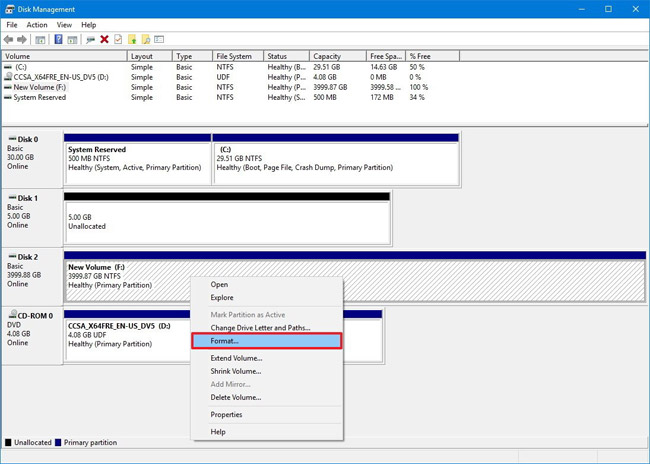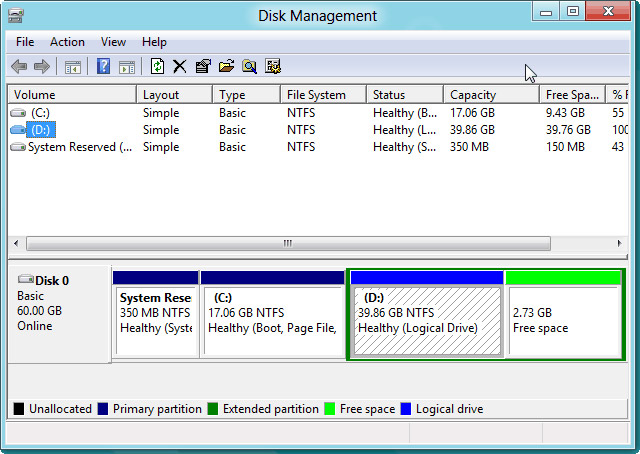How to format the hard drive on Windows
You need to format or format the hard drive if you plan to use it in Windows. Formatting a hard drive means erasing all information on the drive and setting up a file system so that the operating system can read and write data to the drive.
It sounds complicated, but it's not too difficult to format any Windows hard drive. This feature is a very basic function that all operating systems have, and Windows has made it quite easy.
Important note : If the hard drive you want has never been used, or has just been wiped, it needs to be partitioned first. See more 2 articles for detailed instructions:
- Instructions to divide and merge drives right in Windows 7
- Instructions for dividing hard drives right in Windows 10
After the hard drive is partitioned, continue with the following steps to format the hard drive.
Time required: The time required to format the hard drive in Windows depends entirely on the size of the drive, but the overall speed of the computer also plays an important role.
Follow the simple steps below to format the hard drive in Windows 10, Windows 8, Windows 7, Windows Vista or Windows XP.
How to format the hard drive in Windows

1. Open Disk Management, the hard disk manager comes with all versions of Windows.
Note: In Windows 10 and Windows 8, Power User Menu gives you the fastest access to Disk Management. You can also open Disk Management from the Command Prompt in any version of Windows, but opening it through Computer Management is probably easy if you don't know Cmd commands very well.
Check the version of Windows in use if needed.
2. In the currently open Disk Management , find the drive you want to format from the list at the top.
Important note : If the drive you want to format is not in the list above, or the Initialize Disk notification or Initialize and Convert Disk Wizard appears, it means you still need to partition the drive. Partition the drive and move on to the next step.
Note: Drive C or any drive used to store Windows operating systems cannot be formatted from Disk Management or from anywhere else in Windows.
3. When you find the drive to format, right-click or press and hold the drive letter, select Format . The " Format [drive letter] window : " will appear.
Warning: Obviously, selecting the correct drive for the format is very important. Once you start the format, you can't stop. So, if you are formatting a drive with data on it, double-check that the drive is exactly what you want to format by looking at the drive letter and then checking in Explorer. .

4. If you are formatting a new drive, you will not be familiar with the assigned drive letter and the File System may be listed as RAW .
5. In the Volume label , the textbox will either rename the drive or keep the old name. If this is a new drive, Windows will label the new volume label.
We recommend naming the drive for easier identification. For example, if you plan to use this drive to store movies, call it Movies for example.
6. For File System , select NTFS unless you have specific needs and want to choose another File System.
NTFS is always the best File System option in Windows. If there are other specific needs, you can choose FAT32 . Other FAT System Files are only available as optional on 2 GB or less drives.
- How to convert a FAT32 hard drive to NTFS on Windows does not lose data
7. Set Allocation unit size to Default or customize it to your needs if desired. But often you have no reason to change it.
8. In Windows 10, 8 and 7, the Perform a quick format option is selected by default but you should not choose but leave the format fully ( Full format ) done.
The quick format will format the hard drive significantly faster than the standard format, but the benefit of the full format is obviously much larger than the quick format.
Windows 10, 8, 7, Vista: In a standard format, every sector on the hard drive is checked for errors and deleted data so that it cannot be recovered by software (especially useful for used drives. use). A quick format ignores bad sector search and filters basic data.
Windows XP: In a standard format, each sector is checked for errors. Quick format ignores this test. Automatically deleting data during formatting is not available in Windows XP.
9. The Enable file and folder compression option is unchecked by default.
Note : File and folder compression can be enabled to save disk space if desired. However, most drives today have a balance between storage space and disk performance, so this feature is not very valuable.
10. Click or click OK at the bottom of the window.
11. Click or click OK when the message " Formatting this volume will erase all data on it. Back up any data you want to keep before formatting. Since you want to continue? " Appears .
12. The hard drive formatting process will begin. You can monitor the drive formatting by viewing the Formatting: xx% process in Status .
Note: Formatting the hard drive in Windows can take a long time if the drive is too large or slow. A 2 GB hard drive may take only a few seconds to format while a 2 TB drive may take a lot more time, depending on the speed of the hard drive and the computer in general.
13. Format is completed when Status changes to Healthy (a few seconds after the format counter reaches 100%).
Windows does not notify you that the drive format is complete.
14. You have just finished formatting or reformatting your hard drive. Now you can use the drive to store files, install programs, back up data . or whatever you want.
Note: If you have created multiple partitions on your hard drive, you can now go back to Step 3 and repeat the steps above to format the additional drive (s).

Data deletion format but not always
When you format the drive in Windows, data may or may not be deleted. Depending on the version of Windows and the type of format, it may still be there, hidden from Windows and other operating systems, but still accessible in certain circumstances.
- How to completely delete data on the computer
If the hard drive you format never needs to be reused, you can skip formatting and delete, instead destroying physical or magnetic.
Some more information about formatting the hard drive in Windows
If you want to format your hard drive so you can reinstall Windows from scratch, keep in mind that your hard drive will automatically be formatted as part of that process.
If you are not satisfied with the drive letter that Windows has assigned during partitioning, you have the right to change it at any time! You can also format a hard drive via Command Prompt using the format command.
See more:
- Computer hard drive is fast, why?
- Increase capacity and speed for hard drives
- 3 ways to check hard drive effectively to help periodically check the hard drive
 How to save your laptop battery with AutoPowerOptionsOK
How to save your laptop battery with AutoPowerOptionsOK How to automatically turn off software on Windows
How to automatically turn off software on Windows 11 tips for maximum battery saving for your phone
11 tips for maximum battery saving for your phone How to set up Instant Replay feature in OBS Studio
How to set up Instant Replay feature in OBS Studio Change any file or folder name in Windows
Change any file or folder name in Windows How to turn all windows on Windows 10 transparent
How to turn all windows on Windows 10 transparent